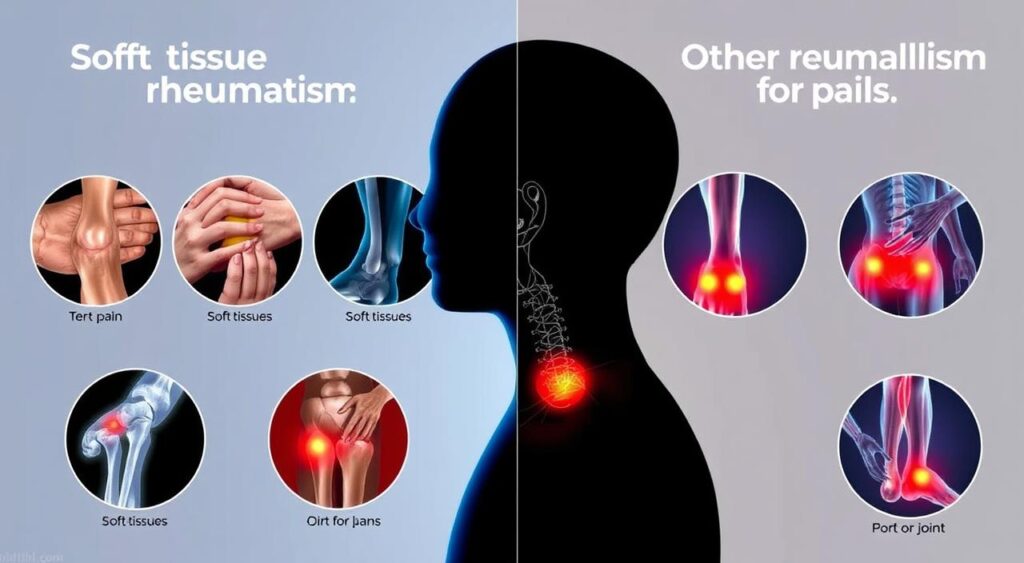Explore effective strategies for managing soft tissue rheumatism, understanding symptoms, and finding relief from muscle and joint pain.
Did you know that about 1 in 5 adults deal with chronic muscle and joint pain? This shows how common soft tissue rheumatism is. It affects muscles, tendons, and ligaments. For many, it makes daily life hard, hurts work, and affects mood.
Learning about soft tissue rheumatism is key for those looking to manage pain. By understanding symptoms, causes, and treatments, people can take back control. As rheumatology learns more about these disorders, it’s vital to spread awareness and offer a detailed guide.

Key Takeaways
- Soft tissue rheumatism includes a range of disorders affecting soft tissues such as muscles and tendons.
- Chronic muscle and joint pain affects a significant portion of the adult population.
- Recognizing symptoms is crucial for proper diagnosis and management.
- Understanding the causes can help in developing preventive measures.
- Effective treatment options can significantly enhance quality of life.
- A proactive approach is essential for managing the emotional and physical impacts of these conditions.
Understanding Soft Tissue Rheumatism
Soft tissue rheumatism affects the soft parts of our body, like tendons, ligaments, and muscles. It can cause a lot of pain and make it hard to move. Conditions like tendinitis, bursitis, myofascial pain syndrome, and fibromyalgia fall under this category.
Fibromyalgia symptoms are similar to those of other soft tissue disorders. These include chronic pain, tiredness, and sensitivity in certain areas. It’s important to recognize these signs to manage and treat them effectively.
Stress can make symptoms of soft tissue rheumatism worse, especially in fibromyalgia. Knowing what causes these disorders helps in finding better treatments. A well-rounded treatment plan can improve life quality and lessen the effects of these conditions.
Common Symptoms of Soft Tissue Disorders
Soft tissue disorders can show up in different ways, affecting people in unique ways. Common symptoms include:
- Localized pain: This is often the most noticeable symptom. It can cause persistent muscle and joint pain that makes daily activities hard.
- Fatigue: Many people feel extremely tired, which can make chronic pain feel worse.
- Stiffness: Muscles might feel tight, especially after resting or being inactive. This can make moving around harder.
- Swelling: Inflammation can cause visible swelling in the affected areas.
These conditions, especially with fibromyalgia symptoms, can be very frustrating. They can really disrupt a person’s life. Chronic pain is a constant reminder of the condition, affecting both physical and emotional health.
It’s important to understand that symptoms can vary from person to person. What works for one might not work for another. So, it’s key to find treatments that fit each person’s unique experience with muscle and joint pain.
Causes of Soft Tissue Rheumatism
Soft tissue rheumatism comes from many factors. Genetics play a big role in connective tissue disorders. Some people are more likely to get these conditions.
Being exposed to repetitive strain injuries also plays a part. This is common in jobs that require the same movements over and over. It can cause long-term pain and inflammation.
Bad posture, from sitting too long or poor ergonomics, makes soft tissue rheumatism worse. Getting hurt during sports or accidents can also start symptoms.
Autoimmune diseases like rheumatoid arthritis and systemic lupus erythematosus make soft tissue injuries more likely. Stress and not being active can make symptoms worse. It’s key to stay active.
- Genetic Predisposition: Inherited traits affecting connective tissue.
- Repetitive Strain Injuries: Common in various occupations.
- Postural Issues: Poor ergonomics lead to discomfort.
- Acute Injuries: Sudden trauma causing inflammation.
- Autoimmune Conditions: Rheumatoid arthritis affects soft tissues.
- Lifestyle Factors: Sedentary habits and stress contribute significantly.
Knowing what causes soft tissue rheumatism helps people spot symptoms early. It encourages taking action to manage it. This helps keep a healthy lifestyle.
Differences Between Soft Tissue Rheumatism and Other Rheumatologic Conditions
It’s important to know the differences between soft tissue rheumatism and other rheumatologic conditions. Soft tissue rheumatism mainly affects muscles, tendons, and ligaments. On the other hand, conditions like osteoarthritis and rheumatoid arthritis mainly affect joints.
Soft tissue disorders often cause pain, tenderness, and stiffness in specific areas. Systemic rheumatism, however, can cause pain in many joints and may also include symptoms like fever and fatigue. Knowing these differences helps doctors make accurate diagnoses.
| Condition | Symptoms | Causes | Treatment Approaches |
|---|---|---|---|
| Soft Tissue Rheumatism | Localized pain, tenderness, stiffness | Overuse, trauma, inflammation | Physical therapy, analgesics |
| Osteoarthritis | Joint pain, swelling, decreased mobility | Wear and tear, aging | Weight management, exercise |
| Rheumatoid Arthritis | Widespread pain, morning stiffness | Autoimmune response | Immunosuppressants, anti-inflammatories |
Using diagnostic criteria helps doctors tell soft tissue disorders apart from other rheumatologic conditions. Imaging studies like ultrasound or MRI help doctors see where the problem is. This makes it easier to find the right treatment.

Diagnosis of Soft Tissue Rheumatism
Diagnosing soft tissue rheumatism needs a detailed approach. It involves several steps to correctly identify the issue. The first step is a clinical evaluation. This includes a deep look into the patient’s history to understand their symptoms, how long they’ve had them, and what might have caused them.
Physicians then do a physical exam. They check for pain points, how well joints move, and if there’s swelling. These steps are key in figuring out if someone has soft tissue rheumatism. They help doctors see where the patient is starting from health-wise.
After the physical exam, doctors might suggest diagnostic tests to confirm their suspicions. Some common tests include:
| Type of Diagnostic Test | Description |
|---|---|
| MRI | Offers detailed images of soft tissues, enabling visualization of inflammation or damage. |
| Ultrasound | Utilizes sound waves to create images of soft tissues, helping in assessing inflammation around joints. |
| Lab Tests | Blood tests can detect inflammatory markers and rule out other conditions that may mimic symptoms. |
Getting a clear diagnosis of soft tissue rheumatism often needs specialists. Experts in rheumatology and physical medicine are best for this. They know how to read test results and handle complex cases where symptoms can look like other diseases.
Soft Tissue Rheumatism: Effective Treatment Options
Treating soft tissue rheumatism requires a mix of methods. This includes using medications and physical therapy that fit each person’s needs. We will look at key treatments, like pain relief drugs and physical therapy, which are vital for managing symptoms.
Medications for Pain Relief
Pain relief drugs are crucial in treating soft tissue rheumatism. Nonsteroidal anti-inflammatory drugs (NSAIDs) are often the first choice. They help reduce inflammation and ease pain. Corticosteroids are used for severe flare-ups to provide quick relief. Muscle relaxants help with muscle tension and spasms.
Physical Therapy Approaches
Physical therapy is key in managing soft tissue rheumatism. A physical therapist creates a custom exercise program. This program may include:
- Manual therapy techniques to improve movement and lessen pain.
- Stretching exercises to boost flexibility and cut down stiffness.
- Strengthening exercises to support muscles and improve function.
Adding these to the treatment plan helps in recovery and boosts quality of life.

Managing Chronic Muscle and Joint Pain
Chronic muscle and joint pain can really affect your daily life. Finding good self-care strategies is key to managing it. There are many techniques you can try, depending on your situation. Learning about these can help you feel better and move more easily.
Self-Care Strategies
Self-care for rheumatism can make a big difference in your life. Here are some tips:
- Heat and Cold Therapy: Heat can relax tight muscles, and cold packs can cut down on swelling.
- Mindfulness Practices: Mindfulness and meditation can help you relax and reduce stress.
- Sleep Hygiene: Getting enough sleep is crucial. A regular sleep schedule can boost your health.
Importance of Regular Exercise
Regular exercise is good for both your body and mind. It helps strengthen muscles and improve flexibility, which is important for managing pain. You can choose exercises that fit your needs and avoid making your symptoms worse. Here are some good exercise options:
| Exercise Type | Benefits | Recommended Frequency |
|---|---|---|
| Low-Impact Aerobics | Boosts heart health | 3-5 times per week |
| Strength Training | Makes muscles stronger | 2-3 times per week |
| Stretching | Increases flexibility | Daily |
| Yoga | Helps with relaxation and focus | 2-3 times per week |
Alternative Treatments for Rheumatism Relief
Many people with rheumatism look for relief beyond traditional treatments. They try acupuncture and herbal remedies. These options are known for their potential in easing symptoms.
Acupuncture and Massage Therapy
Acupuncture comes from traditional Chinese medicine. It uses thin needles in specific body points. Studies show it can help with rheumatism by reducing pain and improving movement.
Massage therapy works well with acupuncture. It helps relax muscles and ease pain. This makes it a good choice for those with chronic pain.
Herbal Remedies and Supplements
Herbal supplements are popular for pain relief. Turmeric, ginger, and boswellia are known for their anti-inflammatory effects. Many people find them helpful in their daily routine.
But, it’s important to talk to a doctor before trying new herbal treatments. This is because they might interact with other medicines.
| Treatment Type | Description | Potential Benefits |
|---|---|---|
| Acupuncture | Insertion of needles into specific body points | Pain reduction, improved mobility |
| Massage Therapy | Manipulation of soft tissues to relieve tension | Relaxation, muscle pain relief |
| Turmeric | Herbal supplement known for anti-inflammatory properties | Pain reduction, inflammation control |
| Ginger | Natural anti-inflammatory herb | Pain reduction, improved joint function |
| Boswellia | Tree resin with anti-inflammatory qualities | Pain relief, reduction of joint stiffness |
Living with Soft Tissue Disorders
Living with soft tissue disorders means making lifestyle changes. These changes help manage symptoms and improve well-being. Simple habits can make a big difference in how you feel.
Adjusting Lifestyle and Habits
Using ergonomic tools and eating well are key. Stress management and staying connected with others are also important. Here are some lifestyle tips:
- Use ergonomic tools to avoid strain.
- Eat foods that fight inflammation, like fruits and omega-3s.
- Do gentle exercises to keep muscles flexible.
- Try stress-relief methods like deep breathing and meditation.
- Keep in touch with family and friends.
Support Groups and Community Resources
Support groups and community resources are crucial. They offer a place to share and get advice. Online forums and local groups provide tailored help. Here are some resources:
| Type of Resource | Description | Benefits |
|---|---|---|
| Support Groups | Local or virtual groups that meet regularly. | Shared experiences and emotional support. |
| Online Forums | Websites dedicated to discussions about living with disorders. | 24/7 support access from a wide community. |
| Local Organizations | Community-based groups offering resources and events. | Access to educational materials and physical activities. |
Conclusion
In this summary, we’ve looked into soft tissue rheumatism. We’ve covered its symptoms, causes, and how it differs from other rheumatologic disorders. It’s key to understand soft tissue rheumatism well. Knowing the signs helps people get the right medical help and live better lives.
We’ve talked about how to manage soft tissue rheumatism. This includes medicines, physical therapy, and even acupuncture and herbal supplements. These methods are crucial for those dealing with chronic pain. They show the importance of a complete approach to health, including lifestyle choices.
Remember, there’s help for those with soft tissue disorders. Talk to doctors, join support groups, and learn about your condition. By taking action, you can better manage your symptoms. This way, you can live your life to the fullest.
FAQ
Q: What is soft tissue rheumatism?
A: Soft tissue rheumatism affects muscles, tendons, and ligaments. It causes pain, fatigue, and less mobility. This impacts daily life a lot.
Q: What are common symptoms of soft tissue disorders?
A: Symptoms include pain, stiffness, and swelling. People might feel chronic pain like in fibromyalgia. The pain’s intensity and frequency vary a lot.
Q: How are soft tissue rheumatism and fibromyalgia related?
A: Fibromyalgia is a soft tissue disorder with widespread pain. It’s often linked with other connective tissue disorders. This makes diagnosis and treatment tricky.
Q: What causes soft tissue rheumatism?
A: Causes include repetitive strain injuries and genetic factors. Lifestyle choices like sitting too much and poor posture can also cause it.
Q: How is soft tissue rheumatism diagnosed?
A: Doctors use a clinical evaluation and patient history. They might also do MRIs and ultrasounds. These tests help confirm the diagnosis.
Q: What treatment options are available for soft tissue rheumatism?
A: Treatments include pain relief meds and physical therapy. Lifestyle changes are also important. Specialized therapies might be needed for tendinitis and myofascial pain.
Q: Are there alternative treatments for managing soft tissue rheumatism?
A: Yes, options like acupuncture and massage can help. Herbal remedies might also offer relief. These can be used with traditional treatments.
Q: What lifestyle changes can help manage symptoms?
A: Regular exercise and using heat or cold therapy help. Good sleep and stress management are key. Making ergonomic changes in daily life also reduces discomfort.
Q: Where can I find support for living with soft tissue disorders?
A: Support groups and online forums offer help. They provide information and connect you with others. This boosts emotional well-being and resilience.
